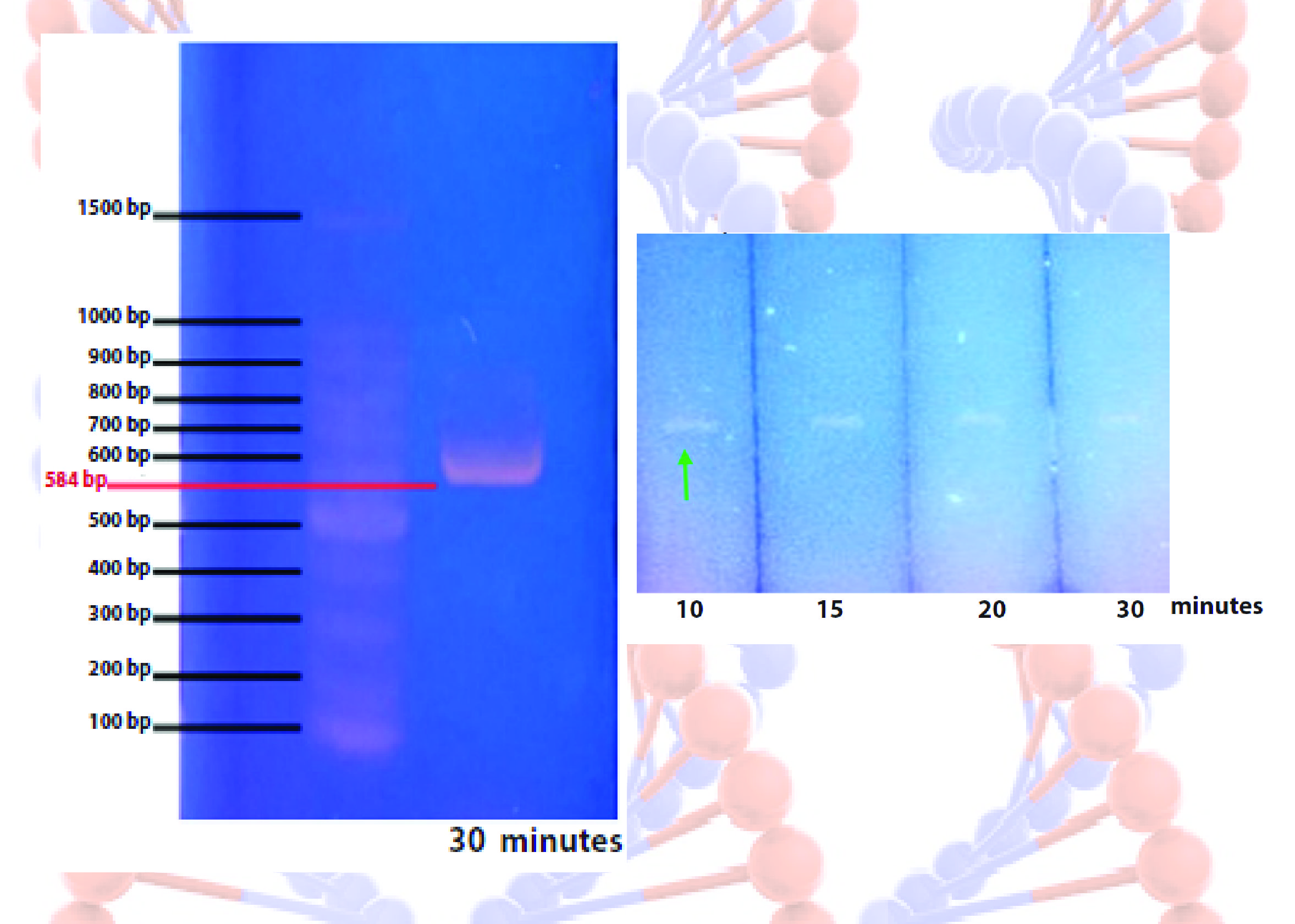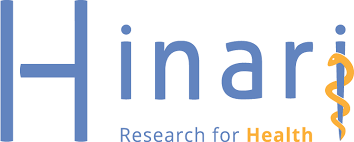OPTIMIZATION OF CONCENTRATION AND SOAKING TIME OF HARRIS HEMATOXYLIN IN DNA BAND EXAMINATION USING ELECTROPHORESIS

Downloads
Background: Deoxyribonucleic acid (DNA) molecules can be effectively visualized when stained and observed under ultraviolet light during the electrophoresis process. The commonly used dye Ethidium bromide (EtBr) is considered hazardous due to its potential to cause mutations, cancer, and congenital disabilities. Various alternative dyes have been reported, one of which is hematoxylin. Hematoxylin compounds do not have mutagenic potential and are easier to apply than EtBr. However, there is no optimal variation in concentration and duration of staining for clear and effective visualization of DNA bands. Purpose: To find the concentration and staining time of harris hematoxylin staining for DNA bands from agarose gel electrophoresis. Method: An experimental method with a group comparison statistical design. The amplified DNA I6S rRNA gene from Escherichia coli (584 bp), which had undergone electrophoresis, was stained using harris hematoxylin dye at 0.01%; 0.02%; 0.03%; 0.04%; and 0.05% concentrations and immersion times soaking times of 10, 15, 20, and 30 minutes variations. The intensity of the DNA bands was analyzed using ImageJ. The staining power of the experimental groups was compared to the intensity of control dye and given a grading score of 1 - 4. The experiment was repeated twice, and the mean grading score was calculated. The highest mean value was considered the most optimal value. Result: A concentration of 0.02% showed relatively constant staining intensity for each soaking time. A mean value of 3.5 was obtained for a 0.01% concentration for 15 minutes. A 0.03% and 0.04% concentrations for 20 minutes. Conclusion: The highest mean value of 4 was obtained for Harris hematoxylin at 0.05% for 15 minutes.
Abdullah, K., 2019. Pengaruh Lama Waktu pada Pewarnaan Hematoxylin sebagai Pengganti Ethidium Bromide untuk Visualisasi DNA Hasil Elektrforesis Gel Agarose. Poltekkes Kemenkes Bandung.
Artati, D., 2016. Sensivitas Gel Red sebagai Pewarna DNA pada Gel Elektroforesis. Buletin Teknik Litkayasa Akuakultur Vol. 11(1), Pp. 11-14.
Artati, D., Lubis, D.S., 2017. Optimasi Performa DNA Marker pada Elektroforesis Gel. Buletin Teknik Litkayasa Akuakultur Vol. 15(2), Pp. 47-50.
Azwar, S., 2016. Reliabilitas dan Validitas. Buletin Psikologi Vol. 3(1), Pp.19-26.
Fatchiyah, Arumingtyas, E.L., Widyarti, S., Rahayu, S., 2018. Biologi Molekular : Prinsip Dasar Analisis, 1st ed. Erlangga, Jakarta.
Ferreira, T., Rasband, W., 2012. ImageJ User Guide. IJ 1.46r.
Geneaid, 2020. Viral Nucleic Acid Extraction Kit II.
Green, M.R., Sambrook, J., 2019a. Analysis of DNA by Agarose Gel Electrophoresis - PubMed. Cold Spring Harbor Protocols Vol. 2019(1).
Green, M.R., Sambrook, J., 2019b. Agarose Gel Electrophoresis. Cold Spring Harb Protoc Vol. 2019(1), pdb.prot100404.
Green, M.R., Sambrook, J., 2020. Recovery of DNA from Low-Melting-Temperature Agarose Gels: Organic Extraction. Cold Spring Harb Protoc Vol. 2020(3), Pp. 100461.
Harahap, M., 2018. Elektroforesis: Analisis Elektronika terhadap Biokimia Genetika. CIRCUIT: Jurnal Ilmiah Pendidikan Teknik Elektro Vol. 2(1).
Huang, Q., Baum, L., Fu, W.-L., 2010. Simple and Practical Staining of DNA with GelRed in Agarose Gel Electrophoresis. Clin Lab Vol. 56(3-4), Pp. 149-152.
Ismaun, I., Muzuni, M., Hikmah, N., 2021. Molecular Detection of Escherichia coli Bacteria as A Cause of Diarrhic Disease using Techniques of PCR. Bioma Vol. 6(2), Pp. 1-9.
Japaridze, A., Benke, A., Renevey, S., Benadiba, C., Dietler, G., 2015. Influence of DNA Binding Dyes on Bare DNA Structure Studied with Atomic Force Microscopy. Macromolecules Vol. 48(6), Pp. 1860-1865.
Kiernan, J.A., 2018. Does Progressive Nuclear Staining with Hemalum (Alum Hematoxylin) Involve DNA, and What is The Nature of The Dye-Chromatin Complex? Biotech Histochem Vol. 93(2), Pp. 133-148.
Lee, P.Y., Costumbrado, J., Hsu, C.-Y., Kim, Y.H., 2012. Agarose Gel Electrophoresis for the Separation of DNA Fragments. J Vis Exp Pp. 3923.
Llewellyn, B.D., 2009. Nuclear Staining with Alum Hematoxylin -. Biotech Histochem Vol. 84(4), Pp.159-177.
Lukemiller, 2010. Analyzing gels and western blots with ImageJ – lukemiller.org.
Mustika, A.A., Suripti, S., Yulistania, T., Ahmad, T.L.S., Muntamah, L., Suryanda, A., 2020. Biologi Molekuler Mata Pelajaran Biologi Madrasah Aliyah. Kementrian Agama Republik Indonesia, Jakarta.
Nurhayati, B., Darmawati, S., 2017. Download Ebook Biologi Sel dan Molekuler, 1st ed. Pusat Pendidikan Sumber Daya Manusia Kesehatan, Badan Pengembangan dan Pemberdayaan Sumber Daya Manusia Kesehatan.
Ortiz-Hidalgo, C., Pina-Oviedo, S., 2019. Hematoxylin: Mesoamerica's Gift to Histopathology. Palo de Campeche (Logwood Tree), Pirates' Most Desired Treasure, and Irreplaceable Tissue Stain - PubMed. International Journal of Surgical Pathology Vol. 27(1), Pp. 4-14.
Prieto, D., Aparicio, G., Machado, M., Zolessi, F.R., 2015. Application of The DNA-Specific Stain Methyl Green in The Fluorescent Labeling of Embryos. J Vis Exp Vol. 2(99), Pp. e52769.
Promega, 2021. GoTaq® Green Master Mix Protocol.
Saeidnia, S., Abdollahi, M., 2013. Are Other Fluorescent Tags Used Instead of Ethidium Bromide Safer? DARU Vol. 21(1), Pp. 71.
Sinaga, A., Putri, L.A.P., Bangun, M.K., 2017. Analisis Pola Pita Andaliman (Zanthoxylum Acanthopodium D.C) Berdasarkan Primer OPD 03, OPD 20, OPC 07, OPM 20, OPN 09. Agroekoteknologi Vol. 5(1), 1Pp. 09236.
Sismindari, Sudjadi, Jenie, R.I., 2019. Genom Ekspresi dan Aplikasinya. Bursa Ilmu, Yogyakarta.
Yuwono, T., Safitri, A., 2017. Biologi Molekuler, 1st ed. Penerbit Erlangga, Jakarta.
Copyright (c) 2024 Journal of Vocational Health Studies

This work is licensed under a Creative Commons Attribution-NonCommercial-ShareAlike 4.0 International License.
- The authors agree to transfer the transfer copyright of the article to the Journal of Vocational Health Studies (JVHS) effective if and when the paper is accepted for publication.
- Legal formal aspect of journal publication accessibility refers to Creative Commons Attribution-NonCommercial-ShareAlike (CC BY-NC-SA), implies that publication can be used for non-commercial purposes in its original form.
- Every publications (printed/electronic) are open access for educational purposes, research, and library. Other that the aims mentioned above, editorial board is not responsible for copyright violation.
Journal of Vocational Health Studies is licensed under a Creative Commons Attribution-NonCommercial-ShareAlike 4.0 International License














































